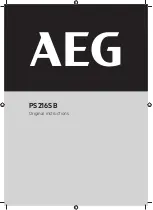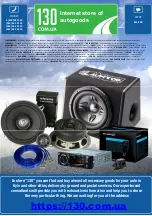
10
18. Check damaged parts
–
Before further use of the tool, a guard or other part
that is damaged should be carefully checked to
determine that it will operate properly and perform
its intended function. Check for alignment of mov-
ing parts, free running of moving parts, breakage
of parts, mounting and any other condition that
may affect its operation. A guard or other part that
is damaged should be properly repaired or
replaced by an authorized service facility unless
otherwise indicated in this instruction manual.
Have defective switches replaced by an authorized
service facility. Do not use the tool if the switch
does not turn it on and off.
19. Warning
–
The use of any accessory or attachment, other
than recommended in this instruction manual, may
present a risk of personal injury.
–
Ensure that the battery pack is correct for the tool.
–
Ensure that the outside surface of battery pack or
tool is clean and dry before plugging into charger.
–
Ensure that batteries are charged using the cor-
rect charger recommended by the manufacturer.
Incorrect use may result in a risk of electric shock,
overheating or leakage of corrosive liquid from the
battery.
20. Have your tool repaired by a qualified person
–
This tool is constructed in accordance with the rel-
evant safety requirements. Repairs should only be
carried out by qualified persons using original
spare parts, otherwise this may result in consider-
able danger to the user.
21. Disposal of battery
–
Ensure battery is disposed of safety as
instructed by the manufacturer.
IMPORTANT SAFETY INSTRUCTIONS FOR
BATTERY CARTRIDGE
ENC005-1
1.
Before using battery cartridge, read all instruc-
tions and cautionary markings on (1) battery
charger, (2) battery, and (3) product using bat-
tery.
2.
Do not disassemble battery cartridge.
3.
If operating time has become excessively
shorter, stop operating immediately. It may
result in a risk of overheating, possible burns
and even an explosion.
4.
If electrolyte gets into your eyes, rinse them out
with clear water and seek medical attention right
away. It may result in loss of your eyesight.
5.
Do not short the battery cartridge:
(1) Do not touch the terminals with any conduc-
tive material.
(2) Avoid storing battery cartridge in a container
with other metal objects such as nails, coins,
etc.
(3) Do not expose battery cartridge to water or
rain.
A battery short can cause a large current flow,
overheating, possible burns and even a break-
down.
6.
Do not store the tool and battery cartridge in
locations where the temperature may reach or
exceed 50°C (122°F).
7. Do not incinerate the battery cartridge even if it
is severely damaged or is completely worn out.
The battery cartridge can explode in a fire.
8. Be careful not to drop or strike battery.
SAVE THESE INSTRUCTIONS.
Tips for maintaining maximum battery life
1. Charge the battery cartridge before completely
discharged.
Always stop tool operation and charge the bat-
tery cartridge when you notice less tool power.
2. Never recharge a fully charged battery cartridge.
Overcharging shortens the battery service life.
3. Charge the battery cartridge with room tempera-
ture at 10°C – 40°C (50°F – 104°F). Let a hot bat-
tery cartridge cool down before charging it.
4. Charge the Nickel Metal Hydride battery car-
tridge when you do not use it for more than six
months.
ADDITIONAL SAFETY RULES FOR TOOL
ENB041-3
1. Be aware that this tool is always in an operating
condition, because it does not have to be
plugged into an electrical outlet.
2. Wear eye protection.
3. Keep hands out of path of saw blade. Avoid con-
tact with any coasting blade. It can still cause
severe injury.
4. Do not operate saw without guards in place.
Check blade guard for proper closing before
each use. Do not operate saw if blade guard
does not move freely and close instantly. Never
clamp or tie the blade guard into the open posi-
tion.
5. Do not perform any operation freehand. The
workpiece must be secured firmly against the
turn base and guide fence with the vise during
all operations. Never use your hand to secure
the workpiece.
6. Never reach around saw blade.
7. Turn off tool and wait for saw blade to stop
before moving workpiece or changing settings.
8. Remove battery from tool before chaging blade
or servicing.
9. Don’t use the tool in the presence of flammable
liquids or gases.
10. Check the blade carefully for cracks or damage
before operation. Replace cracked or damaged
blade immediately.
11. Use only flanges specified for this tool.
12. Be careful not to damage the arbor, flanges
(especially the installing surface) or bolt. Dam-
age to these parts could result in blade break-
age.
13. Make sure that the turn base is properly secured
so it will not move during operation.
14. For your safety, remove the chips, small pieces,
etc. from the table top before operation.
15. Avoid cutting nails. Inspect for and remove all
nails from the workpiece before operation.
16. Make sure the shaft lock is released before the
switch is turned on.
17. Be sure that the blade does not contact the turn
base in the lowest position.
Summary of Contents for BLS820
Page 1: ...Cordless Compound Miter Saw BLS820...
Page 3: ...3 45 8 66 66 45 8 67 2 1 3 4 5 6 7 7 3 8 9 11 10 1 2 3 4 5 6 7 8 3 12 13 5...
Page 6: ...6 43 48 49 50 51 52 53 55 54 42 25 26 27 28 29 30 31 32 25 56...
Page 7: ...7 57 30 29 58 38 61 59 60 33 57 15 28 37 62 63 65 64 33 34 35 36 37 38 39...
Page 15: ...15...
Page 16: ...Makita Corporation Anjo Aichi Japan 884307D226...


































